Poodle Colors — Find Your Favorite
Poodles are popular hypoallergenic dogs and are best known for their fluffy curls. These dogs are extremely intelligent, easy to train, and gentle family dogs. Yet, a pet Poodle requires a lot of grooming to keep their show-stopping coat in prime condition.
If you’re considering this breed, you may want to know more about what Poodle colors are available. If so, all the answers are just a read away.
What Poodle Colors Are There? Contents
The Poodle
Is the Poodle Coat Hypoallergenic?
Standard Poodle Colors
Are Certain Poodle Colors More Expensive?
Conclusion
Poodle Colors FAQs
Often thought to have originated in France, but the Poodle’s heritage comes from Germany. These athletic yet attractive dogs were bred as water retrievers and used during hunts to bring back waterfowl to their masters. Poodles can be seen in artwork from as early as the 14th century but didn’t make their way to North America until approximately the 1700s.
The intelligent Poodle is one of the smartest dog breeds on earth and can be quickly and easily trained, even by first-time pet parents. These tail-waggers possess an independent side, but Poodles are protective of their family and are known to make excellent watchdogs.
Thanks to their natural brainpower, Poodles can pick up new tricks and skills swiftly and perform well on the agility course during dog shows. However, while training may be easy, keeping that curly coat in check isn’t. Poodles of all sizes require a lot of grooming, otherwise, their coat will grow too long and become matted, tangled, and smelly.
Poodles were originally medium-sized dogs, but over the years Giant, Miniature, and Toy/Teacup versions have also been developed. Whatever size Poodle you choose, you will have a loyal, clever, and gentle-natured furry friend.
Is the Poodle Coat Hypoallergenic?
Absolutely. Poodles are known to be one of the best allergy-friendly dog breeds. These popular canines produce very little dander and only shed minimally throughout the year.
The Poodle has hair instead of fur that falls out similarly to us humans, just losing a few strands at a time. And, when the Poodle does shed, any hair or dander becomes trapped inside their dense curls.
Hence, why you should groom your Poodle regularly. Not only to reduce tangles but to remove dead skin cells and hair from their coat.
Poodles are often used for cross-breeding to create hypoallergenic hybrids of otherwise heavy-shedding dogs. To find out more, check out our guide on Poodle Mixes.
Standard Poodle Colors
Poodles were originally either black, white, or brown. Over the years, more and more colors have been introduced into the gene pool. Today the American Kennel Club (AKC) acknowledges 27 different Poodle colors, but only 11 are considered standard for this breed.
To meet the AKC breed standard, Poodles must have a coat made up of one solid and even color — although variations in shade may be acceptable for:
- Gray.
- Silver.
- Brown.
- Cafe-au-lait.
- Apricot.
- Blue.
- Cream.
Let’s take a closer look at the Standard Poodle colors:
Apricot Poodle
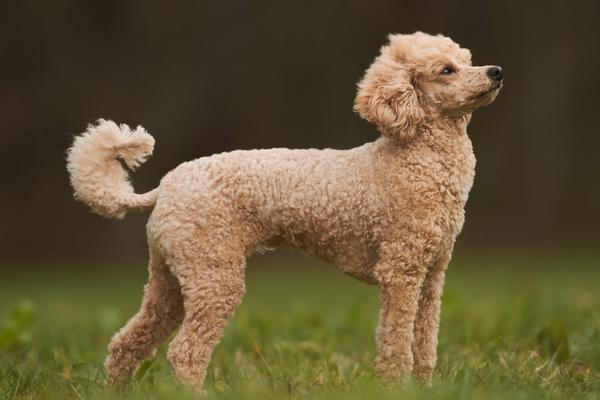
Apricot is one of the newest Poodle colors, and these dogs come in a variety of different shades. Some apricot Poodles have darker hair and look similar to a red Standard Poodle. However, the coat can also be very light and look closer to cream, with a pinkish-red hue.
The first ever apricot Poodle was bred in 1898, and this cute color has grown in popularity over the years. Apricots are available in all sizes, but this color is only possible if puppies inherit the recessive gene. This Poodle color should ideally have black rims around the eyes, as well as a black nose, toenails, and lips.
Black Poodle
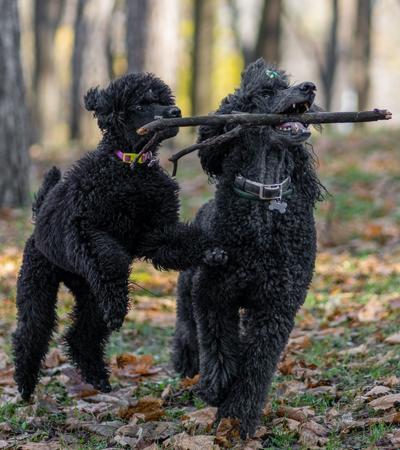
As mentioned, Poodles with black coats are considered an original coat color — dating back as far as the 14th or 15th century.
The black Poodle has been recognized by the AKC since 1887. And, while this breed may be hundreds of years old, this is one of the classic Poodle colors. Hence, despite the availability of more interesting and unusual coat colors, it remains a firm favorite for Poodle parents.
Blue Poodle

All blue Poodles start off as black puppies. However, unlike the black Poodle, whose coat stays the same color throughout its lifetime, blues will fade as they age. The blue Standard Poodle should have ‘cleared’ their black coat by the time they reach 2 years old.
Blues can have lighter roots, but to meet the AKC standard, they must have black points — including their nose, lips, eye rims, and nails. And, their eyes should be dark brown.
Brown Poodle
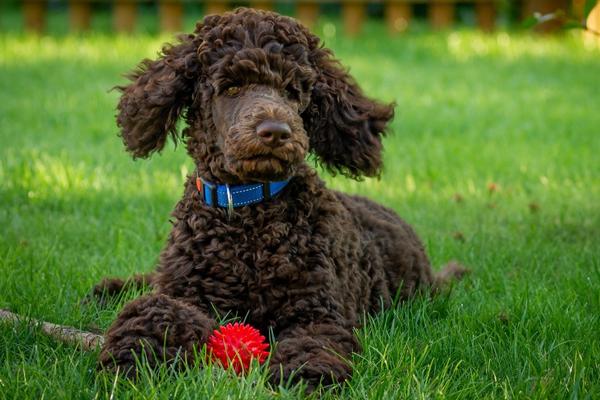
Brown Poodles have a rich, dark brown coat, and their color is a result of the ‘bb’ gene. This gene means zero black pigmentation on a brown Poodle. In comparison, black Poodles carry the ‘BB’ gene.
Poodles of this color have dark amber eyes, and their points will be a liver color, instead of black. As the brown Poodle ages, their coat may become white or gray around their eyes and chin.
Cafe au lait Poodle
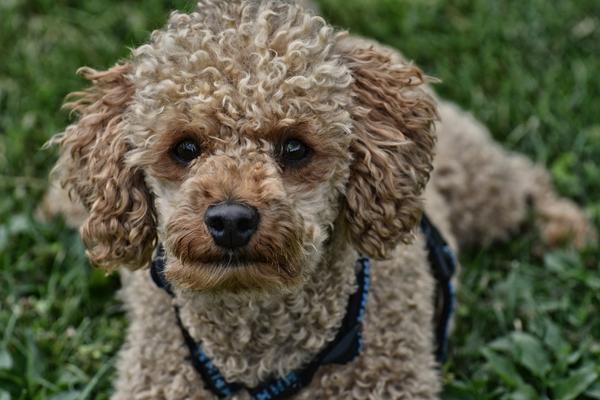
Cafe-au-lait Poodles have a rich yet light and almost creamy brown-colored coat. Like the French coffee they’re named after, these Poodles aren’t exactly brown but aren’t cream or silver beige either.
Often born with a light brown coat, cafe-au-laits lighten as they age. Their eyes should be dark amber, and their points liver-colored.
Cream Poodle

Thanks to their black nose, eye rims, and toenails, the cream Poodle can easily be spotted among a group of cafe-au-laits.
Cream Poodles are bred using the silver beige and the non-dominant gene from the red Poodle. Depending on their heritage, cream Poodles can vary significantly in shade and tone, some have very dark hues and others are almost white.
Gray Poodle
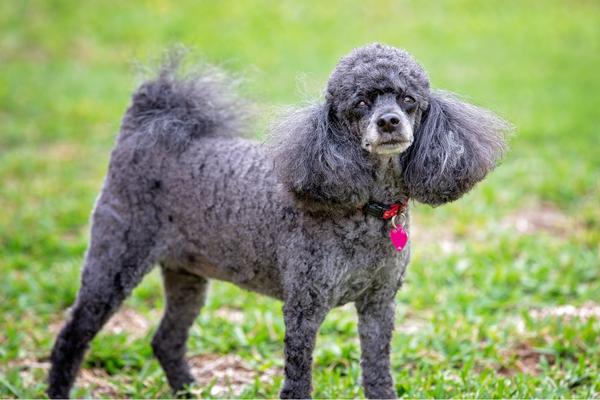
Like humans, Poodles’ hair can fade as they reach old age. Black Poodles may turn lighter as they get older and will gradually turn gray.
However, it is possible to breed gray Poodles by using dogs with a specific recessive gene. Puppies with this gene have coats that fade more quickly and turn fully gray at approximately 2 years of age.
Grey Poodle puppies are born with a black coat. So, bear in mind, you may think you’re buying a black Poodle but end up with a pup with a much lighter coat!
Red Poodle
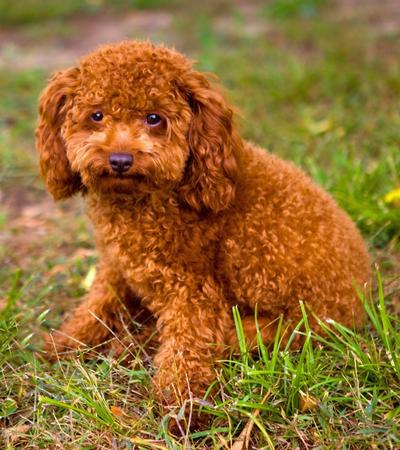
The red Standard Poodle was first classified as an AKC Poodle color in 1980. Confusingly, the red Poodle often comes from a line of apricot-colored Poodles and is the result of a non-dominant gene. Red is one of the rarest Poodle colors.
Reds can often change color throughout their lifetime. Puppies are generally dark with a very obvious red hue to their coat. Yet, as the pups grow, their fur can lighten and turn dark again. Also, owners of brown or tan Poodles have been surprised to see their beloved pooch turn red as they mature.
Silver Poodle
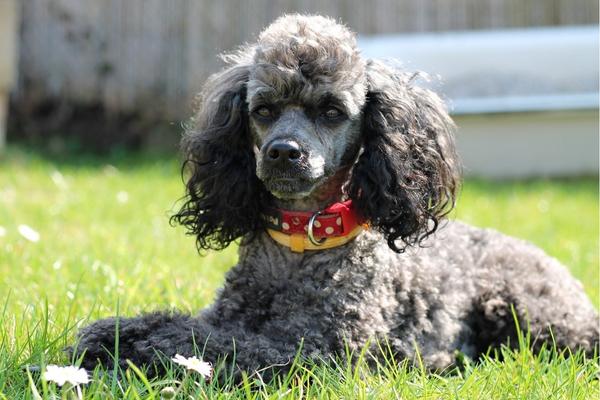
Silver Poodles are another uncommon breed, and two parents with the recessive gene are needed to create these magical-looking beauties. That said, even if both parents are silver, puppies can turn out cream, white, or silver beige.
Like the gray Poodle, Silvers are born black. However, the face and paws will change within the first six weeks of life and the rest of the fur will gradually lighten in time. The silver Poodle will have their ‘forever coat color’ by the time they’re 2 years old.
Silver Poodles have dark brown eyes, and their lips, nose, and eye rims will be black. The Silver Allele V gene is responsible for creating these rare Poodles.
Silver Beige Poodle

The silver beige Poodle is different from the silver breed above. These dogs are born brown, and their coat becomes lighter as they mature. A true silver beige has a coat that’s almost diluted brown in color, with liver points.
Cafe-au-lait and silver beige Poodles are often confused with each other. The key difference between these two is that the latter starts out with brown fur, whereas the cafe-au-lait is often light at birth.
White Poodle
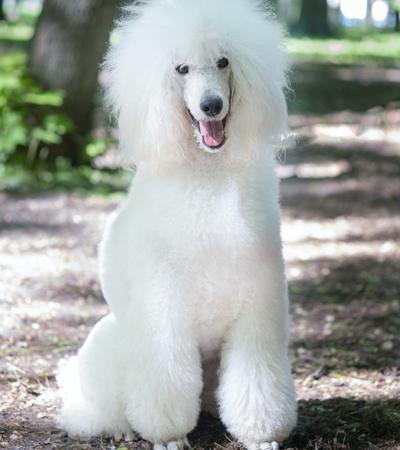
Nothing beats the elegant and regal-like Poodle in white. A pure white Poodle is a snowy white color and won’t have any other shades in their coat. However, there are white Poodles that have a tint of beige or apricot in their hair.
Poodles that are white may have the ticking gene. This causes patches of color on pure white areas, which can make their coat look dirty and this isn’t accepted at canine shows. While white Poodles are a result of a recessive gene, they’re popular and by no means one of the rarest Poodle colors.
Unusual Poodle Colors
When it comes to colors and Poodles, you’re spoilt for choice. These gentle dogs can come in all the standard shades above, as well as some more untraditional hues.
Sable Poodle
Sable Poodles aren’t rare, but they can have different patterns and color combinations. Often sables appear darker at birth, due to the black tips on their hair. As they grow, the primary color of their fur will be more dominant, but they will still have darker ends.
If the sable color isn’t for you, a more even color can be achieved by clipping your Poodle’s fur short and removing the black tips. Common color combinations for sable Poodles include cream, apricot, or brown with black/darker ends.
Black and White Poodle
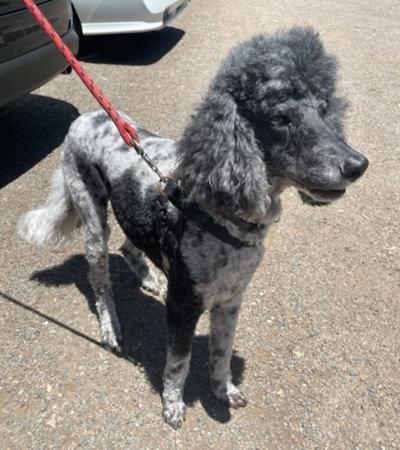
Black and white Poodles are known as parti Poodles. This name is given to Poodle breeds that don’t have a solid coat color. This kind is 50% white, the rest of their coat is a different color. For example, they could be part white and part brown.
Red, blue, black, and tan poodles can also be bred as parti Poodles. These dogs have unique patterns, the different colors look particularly eye-catching on their dense yet fluffy curls.
Brindle Poodle
Brindle is the name used to describe a striped pattern found on several different dog breeds. The brindle gene isn’t rare, so you shouldn’t struggle to find a Poodle with this pattern.
Common brindle Poodle colors include blue, brown, black, silver, and gray. You won’t find a brindle pattern on a white Poodle, and the stripes may only cover specific areas of your dog’s coat.
Merle Poodle
Merle is perhaps one of the most unusual-looking Poodle breeds. These dogs are covered in spots, dashes, and various patterns in a mash-up of colors. A blue merle Poodle, for example, is a black Poodle with silver, gray or white patterns in their fur.
These Poodles lack pigmentation, and this is what causes their unique markings. Also, this reduction of normal pigment can mean merle Poodles have blue eyes and a blue or pink nose.
Phantom Poodle
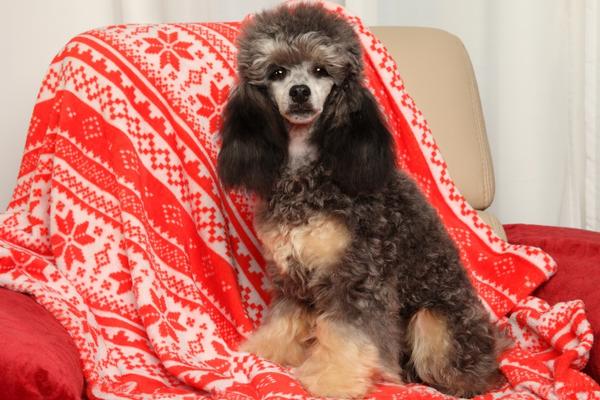
Phantom Poodles are not as creepy as they sound! These dogs simply have a unique set of markings, similar to the Doberman Pinscher. Phantom Poodles have a coat made up of two colors — a solid ‘base color’ and a secondary color that makes up the markings on their chest, eyebrows, legs, cheeks, and the area of fur below their tail.
There are several different phantom color combos. These dogs can be found in black and apricot, brown and cream, and red and apricot.
Tri Color Poodle
To end up with a tri-color you need to get two Poodles with different color markings together. So, generally, they come from mixing a parti and a phantom.
This type of Poodle will often have white legs like a parti, and the rest of their coat will be a different color. Often the only noticeable phantom markings will be found on the dog’s face, usually around the eyebrows.
Tuxedo Poodle
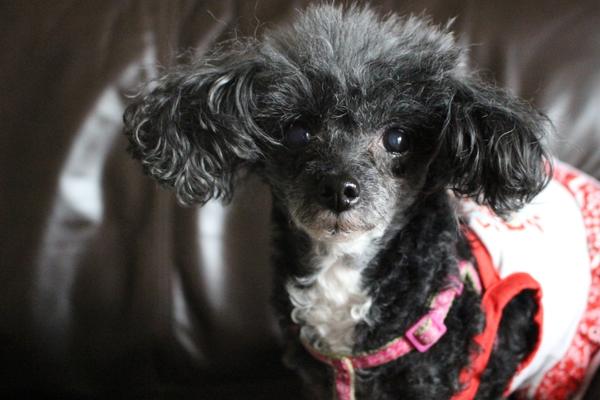
Parti Poodles with a black and white coat and specific markings are known as the tuxedo Poodle. Hence, if your pooch looks like they’re wearing a fancy suit, thanks to the markings on their chest, you may have got yourself a dashing tuxedo.
Are Certain Poodle Colors More Expensive?
As you can see, Poodles come in a cacophony of different colors. There is almost a Poodle for every color of the rainbow! However, be aware that this can influence how much your puppy will cost.
Rarer colors like red and apricot are often more expensive than the popular black or white Poodle. Also, you can expect to pay more for parti Poodles and other breeds with more than one color specifically bred into their coat.
In short, the less common the Poodle color, the higher the price.
Other factors that influence the cost of the Poodle include:
- Bloodline.
- Breed reputation.
- Health screenings.
- Access to registration papers.
Conclusion
When you think of the Poodle, the first thing to come to mind will be their impressive curly coats and fancy grooming. However, these majestic creatures are available in a whole host of different colors too.
Poodles are also found in solid and more than one color. Phantom Poodles, parti Poodles, and tri-color Poodles all have coats made up of base color and specific markings and patterns in another.
However, the most common Poodle colors are black, white, and brown. In contrast, apricots and reds are tough to come by due to the specific genes needed. So, which color is your favorite?
Poodle Colors FAQs
Is the Red Toy Poodle Rare?
Yes. Like the Miniature red Poodle, the red Toy is rare. They’re created from a non-dominant gene and come from the apricot Poodle line.
What Is a Parti Poodle?
A Poodle with a coat that’s half white and has markings in one other secondary color. Common color combinations for a parti Poodle include white and black, white and brown, white and blue, or white and red.
What Is a Silver Beige Poodle?
Silver Beige Poodles are born brown, and as they grow their coat changes color. They will begin to change at around 6 weeks of age, and will have a fully transformed coat by the time they reach 2 years old. These Poodles are a faded brown color and will often have amber eyes.
What Are the Original Poodle Colors?
The very first Poodles in existence were either black, brown, or white. And, despite the choice of colors today, these three still remain popular with Poodle parents.
Can You Get Merle Poodles?
A merle breed doesn’t come in one solid color and this occurs due to a specific genetic mutation. The merle Poodle does exist, but the coat is not naturally occurring in these dogs. It has been introduced by using a different breed that carries the gene.
What’s the Rarest Poodle Color?
The rarest Poodle colors are the red and the apricot Poodle, although there is definitely some debate in the Poodle world.
What Are the Common Colors of Poodles?
Black, closely followed by brown.
What Color Is a Blue Poodle?
The blue poodle is actually like a faded black color. Blue poodles are born black, and their coat color lightens in the first year.
Can Poodles Have 2 Colors?
Yes. They’re known as parti poodles — as in, part one color and part another. Their base coat is typically white, and the secondary shade can be any poodle color — black, brown, red, blue, you name it.


